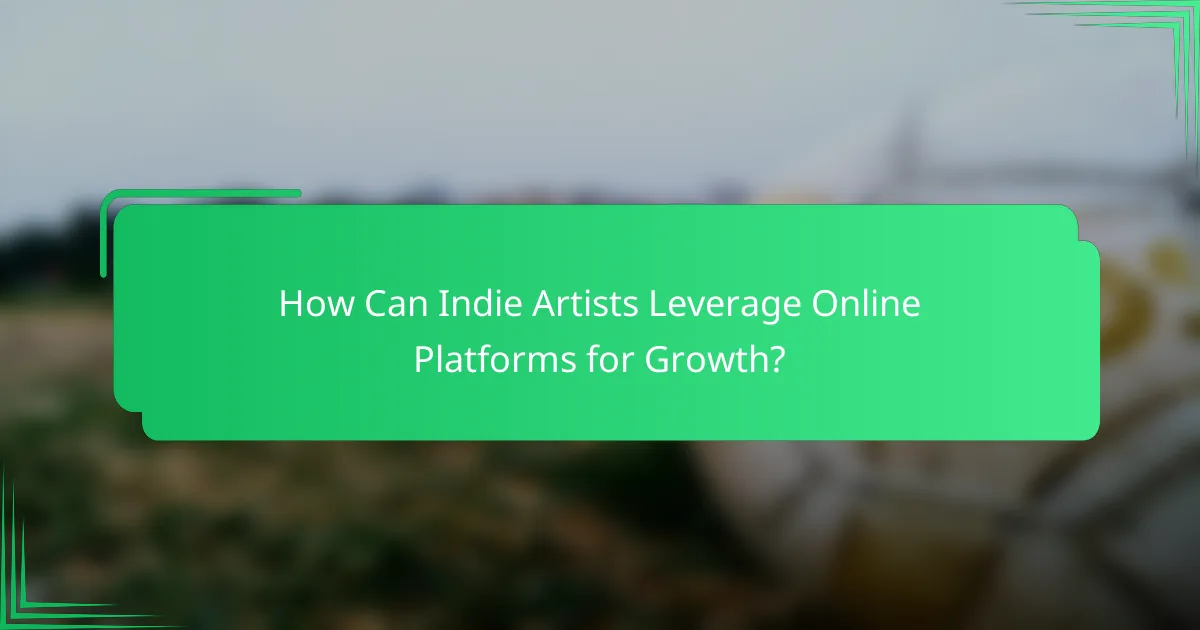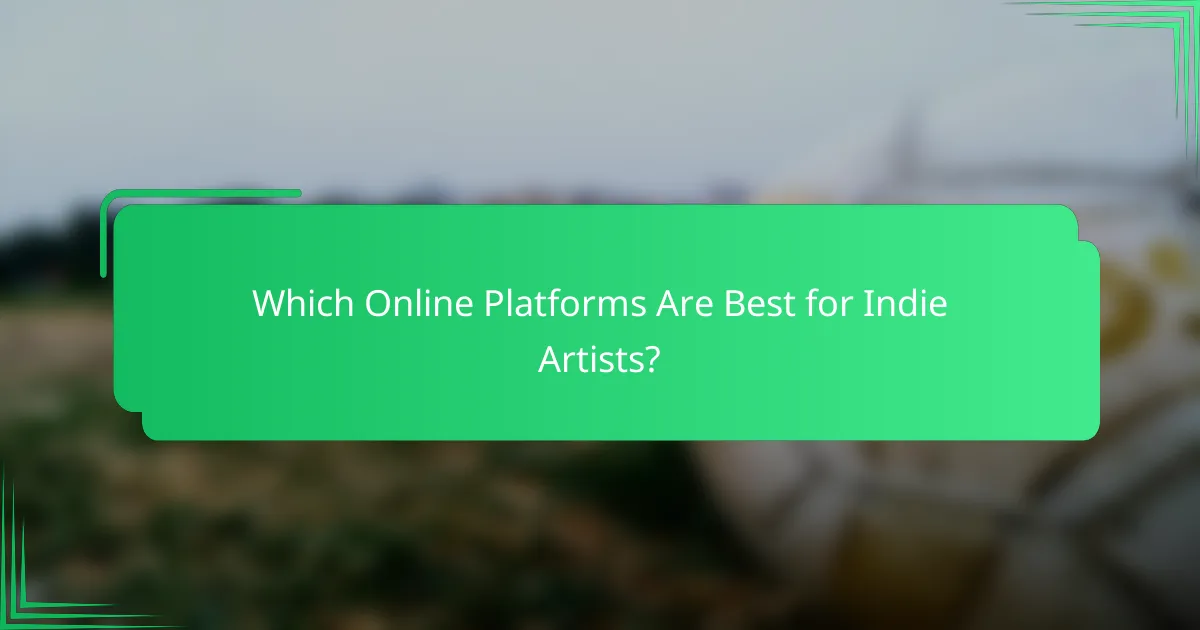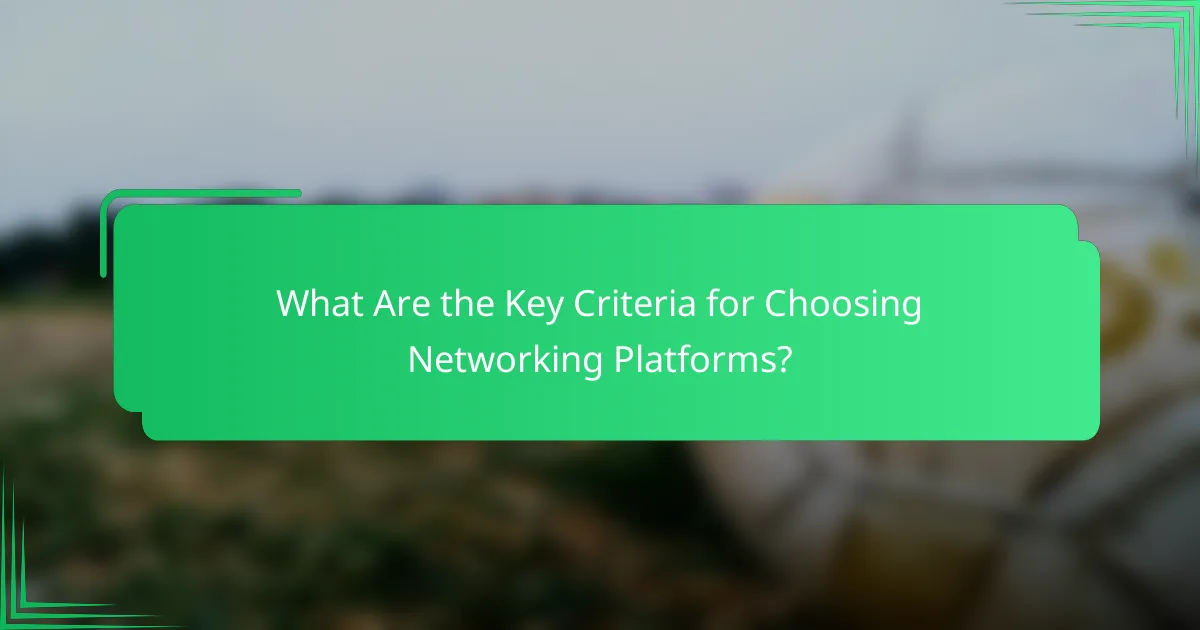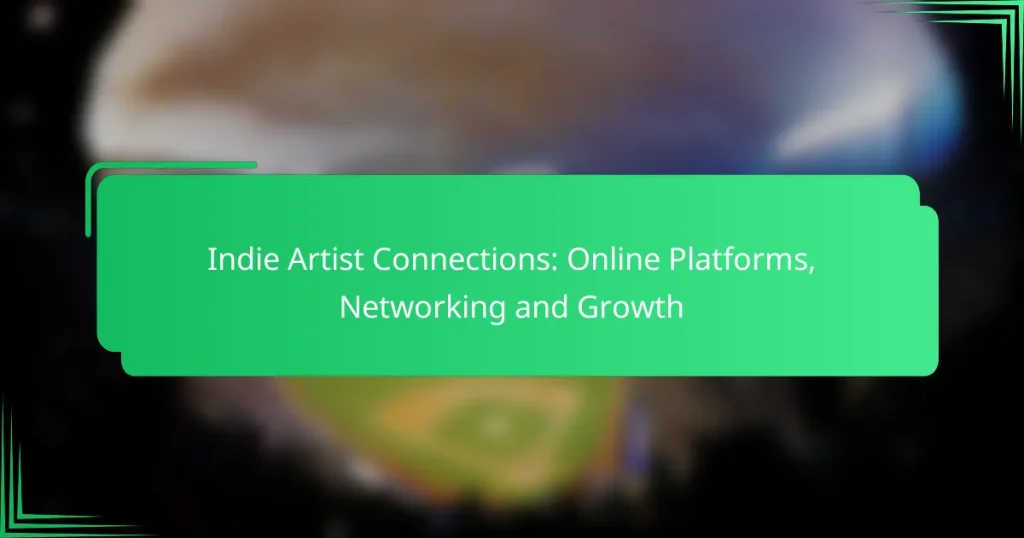In today’s digital age, indie artists have unprecedented opportunities to enhance their visibility and connect with audiences through online platforms. By effectively utilizing these tools, they can reach wider audiences, collaborate with fellow musicians, and distribute their music with ease. Networking opportunities, from virtual events to social media interactions, further enable artists to build valuable connections within the industry and foster growth.

How Can Indie Artists Leverage Online Platforms for Growth?
Indie artists can effectively leverage online platforms to enhance their visibility, connect with fans, and grow their careers. By utilizing various digital tools, they can reach wider audiences, collaborate with other musicians, and distribute their music efficiently.
Social Media Platforms
Social media platforms like Instagram, Facebook, and TikTok are essential for indie artists to build their brand and engage with fans. These platforms allow artists to share their music, behind-the-scenes content, and personal stories, fostering a deeper connection with their audience.
To maximize impact, artists should post consistently and interact with followers through comments and live sessions. Utilizing hashtags and trends can also help increase visibility, attracting new listeners and potential collaborators.
Music Streaming Services
Music streaming services such as Spotify, Apple Music, and Bandcamp are crucial for indie artists to distribute their music and gain exposure. These platforms often have algorithms that can promote tracks to new listeners, especially if artists engage with playlists and submit their music for consideration.
Artists should consider creating their own playlists and collaborating with other musicians to cross-promote their work. Additionally, understanding the payment structures of these services can help artists strategize their releases for maximum financial benefit.
Online Collaboration Tools
Online collaboration tools like Soundtrap, Splice, and BandLab enable indie artists to work with other musicians remotely. These platforms provide features for sharing tracks, editing music, and even video conferencing, making collaboration more accessible regardless of location.
Artists should take advantage of these tools to expand their creative network and explore diverse musical styles. Setting clear goals and deadlines can enhance productivity during collaborative projects.
Content Distribution Networks
Content distribution networks (CDNs) help indie artists distribute their music and content efficiently across various platforms. Services like DistroKid and TuneCore allow artists to upload their music once and distribute it to multiple streaming services and online stores.
Choosing the right CDN involves considering fees, distribution reach, and additional services like royalty collection. Artists should compare options to find a service that aligns with their goals and budget.
Fan Engagement Platforms
Fan engagement platforms such as Patreon and Ko-fi enable indie artists to connect with their supporters directly and monetize their content. These platforms allow artists to offer exclusive content, merchandise, and experiences in exchange for financial support from fans.
To effectively use these platforms, artists should create compelling membership tiers that provide real value to fans. Regular updates and personalized interactions can help maintain engagement and encourage ongoing support.

What Networking Opportunities Exist for Indie Artists?
Indie artists can leverage various networking opportunities to connect with peers, industry professionals, and potential fans. These opportunities range from virtual events to social media interactions, each offering unique benefits for growth and collaboration.
Virtual Music Conferences
Virtual music conferences provide platforms for indie artists to network with industry experts, attend panels, and showcase their work. Events like South by Southwest (SXSW) and Music Biz offer sessions on marketing, distribution, and artist development, often featuring Q&A segments for direct engagement.
To maximize benefits, prepare a concise pitch about your music and goals. Participate actively in discussions and follow up with contacts made during the event. Many conferences also offer networking lounges where you can meet other artists and industry professionals.
Online Workshops and Webinars
Online workshops and webinars are excellent for skill development and networking. These sessions often cover topics such as songwriting, production techniques, and marketing strategies, led by experienced professionals in the music industry.
Look for workshops that include breakout sessions for smaller group interactions. Engaging in these settings allows for deeper connections with instructors and fellow participants. Platforms like Eventbrite and Meetup frequently list relevant workshops tailored for indie artists.
Collaborative Projects with Other Artists
Collaborating with other artists can expand your reach and introduce you to new audiences. Joint projects, such as co-writing songs or creating music videos, can enhance creativity and provide networking opportunities.
Consider reaching out to artists with similar styles or those who complement your sound. Use platforms like SoundCloud or Bandcamp to find potential collaborators. Establish clear communication and set mutual goals to ensure a successful partnership.
Networking on Social Media
Social media is a powerful tool for indie artists to connect with fans and industry professionals. Platforms like Instagram, Twitter, and TikTok allow you to share your music, engage with followers, and network with other artists.
Be consistent in posting content that showcases your personality and music. Engage with other artists by commenting on their posts and sharing their work. Use relevant hashtags to increase visibility and participate in music-related discussions to build relationships within the community.

Which Online Platforms Are Best for Indie Artists?
Indie artists can thrive on various online platforms that cater specifically to their needs for exposure, distribution, and community engagement. The best platforms often provide tools for promoting music, connecting with fans, and analyzing performance metrics.
Bandcamp
Bandcamp is a popular platform for indie artists to sell their music directly to fans. It allows artists to set their own prices and offers options for digital downloads, physical merchandise, and even vinyl pressing.
One key feature is the ability to offer fans the option to pay more than the set price, which can lead to higher earnings. Artists can also create special offers and discounts to encourage purchases, making it a flexible tool for monetization.
SoundCloud
SoundCloud is known for its user-friendly interface and vast community of music creators and listeners. It allows indie artists to upload tracks, share them easily, and engage with fans through comments and likes.
With features like SoundCloud Pro, artists can access advanced analytics to track listener engagement and gain insights into their audience. This platform is particularly effective for artists looking to build a following and collaborate with other musicians.
ReverbNation
ReverbNation offers a suite of tools designed to help indie artists manage their careers. It provides opportunities for music distribution, promotional campaigns, and even licensing deals.
Artists can create a profile to showcase their music and connect with industry professionals. The platform also features opportunities for live gigs and contests, giving artists additional avenues for exposure and growth.
Spotify for Artists
Spotify for Artists is essential for indie musicians aiming to reach a global audience. This platform not only allows artists to distribute their music but also provides valuable insights into listener demographics and streaming performance.
Artists can customize their profiles, promote new releases, and even pitch songs for playlist consideration. Engaging with fans through Spotify’s Canvas feature can also enhance the listening experience and foster a deeper connection with the audience.

What Are the Key Criteria for Choosing Networking Platforms?
When selecting networking platforms, indie artists should prioritize alignment with their target audience, the features and tools available, and the cost versus revenue potential. These criteria help ensure that the chosen platforms effectively support growth and engagement within the music community.
Target Audience Alignment
Understanding your target audience is crucial when choosing a networking platform. Look for platforms where your potential fans and collaborators are active, such as social media sites, music streaming services, or artist-specific forums. Engaging with the right audience can significantly enhance your visibility and opportunities.
Consider demographics such as age, location, and musical preferences. For instance, platforms like TikTok may appeal more to younger audiences, while Facebook might cater to a broader age range. Tailoring your choice to where your audience spends their time can lead to more meaningful connections.
Features and Tools Offered
Evaluate the features and tools provided by each networking platform to determine their suitability for your needs. Essential features may include promotional tools, analytics, collaboration options, and community engagement capabilities. Platforms like Bandcamp offer direct sales and fan engagement tools, while SoundCloud focuses on music sharing and feedback.
Additionally, consider how user-friendly these tools are. A platform that is easy to navigate and offers robust support can save you time and enhance your networking efforts. Look for platforms that allow you to showcase your work effectively and connect with other artists and fans seamlessly.
Cost and Revenue Potential
Assessing the cost of using a networking platform is vital for indie artists, as many platforms have different pricing structures. Some may charge monthly fees, while others take a percentage of sales or offer free basic services with premium upgrades. Understanding these costs helps you budget effectively and avoid unexpected expenses.
Also, consider the revenue potential of each platform. For example, platforms that allow direct sales or monetization options can provide a better return on investment. Weigh the costs against the potential revenue to determine which platforms can help you grow your music career sustainably.

How Can Indie Artists Measure Their Growth Online?
Indie artists can measure their growth online by utilizing various analytics tools and metrics that track engagement and reach across platforms. Understanding these metrics helps artists assess their audience, improve their strategies, and ultimately enhance their online presence.
Analytics Tools
Analytics tools provide valuable insights into an artist’s online performance. Platforms like Google Analytics and Bandcamp Analytics allow indie artists to track website traffic, user behavior, and sales data. By regularly reviewing these metrics, artists can identify trends and adjust their marketing strategies accordingly.
Consider setting specific goals, such as increasing website visits by a certain percentage or boosting sales from digital downloads. This targeted approach can help artists focus their efforts on areas that yield the best results.
Social Media Engagement Metrics
Social media engagement metrics are crucial for indie artists to understand how their content resonates with audiences. Key metrics include likes, shares, comments, and follower growth across platforms like Instagram, Facebook, and Twitter. Regularly monitoring these metrics can reveal which types of content generate the most interaction.
To enhance engagement, artists should aim for consistent posting and actively interact with their followers. A common pitfall is neglecting to respond to comments or messages, which can diminish audience connection and loyalty.
Streaming Service Insights
Streaming services like Spotify and Apple Music offer insights into how often songs are played and who is listening. These platforms provide data on listener demographics, geographic locations, and playlist placements. This information can guide artists in tailoring their promotional efforts to specific audiences.
Indie artists should regularly check their streaming analytics to identify popular tracks and potential markets for touring or merchandise. Utilizing this data can lead to more effective marketing strategies and increased fan engagement.


